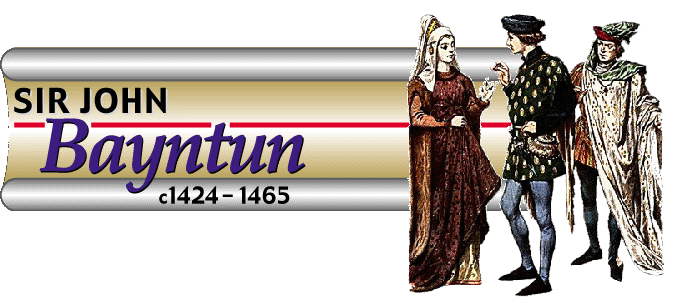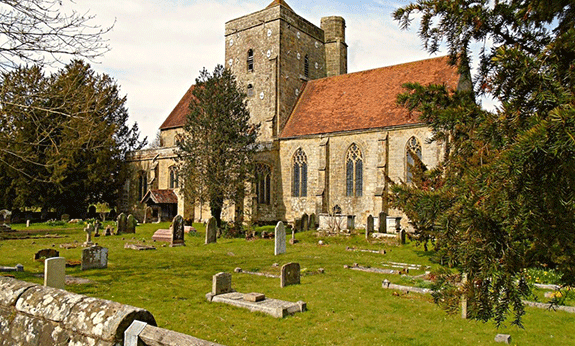
|
Timeline
1428: Joan of Arc began campaigning against English forces in France. 1429: Henry VI was finally crowned King of England on 6th November at Westminster Abbey, Middlesex. He was not the aggressive King England wanted, and he hated bloodshed, yet he remained on the throne for 37 years. 1430: Henry VI was crowned King of France on 2nd December at St. Denis in Paris. 1431: Henry VI – the only sovereign to have been crowned in both England and France. Joan of Arc was burnt at the stake. 1435: The English slowly lose France, except Calais. 1436: The French, under Charles VII regained Paris from the English. |
Married:
There is no documented proof of this marriage, although it is mentioned in the 1623 Visitation.
John Bayntun was born circa 1424, at Faulston House, in the County of Wiltshire, however the exact date of his birth is not known. His father, Sir John Bayntun, died in 1447 and he inherited his estates, including the Manor of Fallerstone (now known as Faulston). Medieval documents refer to him as John Baynton, however the family changed the spelling of their surname to Bayntun sometime around the beginning of the 17th century. He was an experienced soldier and entrusted with a series of commissions between 1449 and 1465. John Bayntun is said to have married Joan Echingham, the eldest daughter of Sir William Echingham and Joan FitzAlan De-Arundel of Etchingham, Co. Sussex, with whom he had six children. Sadly there is no records of the death of Joan Echingham or the birth of her children. But some years later, Sir John remarried Katherine Payne, the daughter of Thomas Payne of Payneshay, Devonshire and the widow of John Stourton of Preston Plunkett, Somerset. There is great confusion and uncertainty about this first marriage to Joan Echingham, as Joan's mother died on the 1st September 1404. Even assuming that she died during childbirth, Joan would be at the very least 20 years older than John. The eldest son, and heir, from this dubious marriage was called Robert Bayntun, who was born in 1439. This would have made Joan 35 years old and John Bayntun approximately 15 years of age at this time. John's date of birth is also uncertain and if we were to allow for error and perhaps assume that he could quite possibly be a couple of years older, there would still be a considerable age gap between he and Joan. This is not entirely impossible, if such a marriage was arranged, but nevertheless it is not supported by any sound documentary evidence and therefore there are suggestions that Robert Bayntun may very well have been born to John's second wife, Katherine. This would seem more likely, as Katherine Payne was the third wife of John Stourton, who died on the 10th November 1438. If she married, John Bayntun shortly afterwards, then it is likely that Robert Bayntun (born 1439) could be the son and heir from this marriage and the other children could also be from this marriage. Because Robert was named heir to his father, it would not necessarily be the case that he was the first born. Some of his other brothers may well have been born before him to Joan Echingham but had died before their father. While there is also no absolute proof that Joan Echingham was the mother of any of Sir John's children, she was named in the Great Pedigree and Visitation of 1623, and it is safe to presume she could have been the mother of some of them, unless proven otherwise. John Bayntun was appointed Knight of the Shire and M.P. for Wiltshire in 1449 and was also the owner of a property, very likely an Inn, called Le Abbay in Culver Street, Salisbury about this time. On the 8th February 1449, he was on a Commission to enquire touching all wards, marriages, etc. in Wiltshire, concealed from the King. Also on the 1st August, he was a Distributor of an Allowance on a Tax in Wiltshire. A document dated the 20th September 1450, lists John Bayntun, knight; Robert Hungerford, knight, Lord of Hungerford; Robert Hungerford, knight, Lord of Molyns; William Beauchamp, knight, Lord Saint Amand; and others, as Commissioners – appointing them to call together all the King's lieges of whatsoever estate, rank and condition to go with them against the traitors and rebels in Wiltshire and counties adjacent and to arrest and judge the same. On the 6th March 1451, Sir John was on a Commission to enquire into the forcible entry into the close and houses of John Crekemore in Salisbury and on the 1st December that year, he was one of those commissioned to deliver a prisoner to Gaol at Old Sarum Castle. On the 16th March 1453, he was on a Commission of the Peace for Wiltshire. On the 28th November 1454, he was on a Commission of the Peace for Wiltshire. On the 5th December 1455, Sir John Bayntun was appointed a Commissioner to assist the Duke of York put down the Devon Rights. The Duke of York had returned, uninvited, to England from Ireland, where he had been in semi-exile. This was the beginning of a civil war which originated from a bloody dynastic dispute between York's family and the reigning Lancastrians, fought in several spasmodic episodes between 1455 and 1487, in a conflict known as the Wars of the Roses. On the 14th February 1456, he was on a Commission of the Peace for Wiltshire and on the 10th November, in the same year, he was again recorded as a Commissioner of the Peace for the county. On the 3rd February 1457, Sir John was on a Commission of the Peace for Wiltshire and on the 17th December, that same year, he was on a Commission of Array for Wiltshire, Somerset and Dorset. At this particular time, he was also on a Commission to assign how many archers each part of Wiltshire should have. On the 28th January 1458, he was on a Commission of the Peace for Wiltshire and on the 5th September, in the same year, he was on another Commission of Array for Wiltshire. "A Commission of Array" was a commission given by English royalty to officers or gentry in a given territory to muster and array the inhabitants, or see them in a condition for war. Commissions of Array developed from the ancient obligation of all free men to defend their country. Commissioners were usually experienced soldiers, appointed by the crown to array able bodied men from each Shire. By the time of the Wars of the Roses conscript levies were less important than troops raised by indenture. In 1459, Sir John was an Elector for Wiltshire. On the 20th January 1461, he was on a Commission to arrest certain men in Wiltshire. On the 30th November 1462, he was one of those appointed to deliver a prisoner to the Gaol at Old Sarum Castle. On the 13th December 1464, Sir John was a feoffee of Robert, late Lord Hungerford, in Wiltshire. "Feoffees" were some of the better-off men of the town who could be trusted to administer property and distribute the proceeds in an honest manner. There is a mention of Sir John Bayntun in a Tourn (a type of court roll for the local business of the village of Faulston), dated 1465, relating to arable land, lately John Bayntun knight and Michael Kymer, fee tenant. Presumably Kymer had taken over some land previously farmed by John Bayntun but had not paid his rent. Sir John Bayntun died on the 20th June 1465 and his wife Katherine remarried again, in 1468, for the third time, to William Caren MP of Taunton, Somerset, Steward of Shaftesbury Abbey and Agent for the Duke of Somerset. But three years later, in 1471, both William Caren and Sir Robert Bayntun, Katherine's son, were charged with high treason after the Battle of Tewkesbury, their possessions confiscated by the new Lancastrian king, Henry VI. Both attainees were witnessed by local men named John Watts and Robert Browne. There is no record of the burial place of Sir John Bayntun, but it is thought he and his family before him, may have been buried in a square field, known as Chapel Close, which might have been either the site of a Chapel or a field attached to the Chapel which was next to Faulston House. There are no visible signs of any graves today, unless buried beneath the ground. Katherine died in 1473 and at this time the Manor of Faulston and the Manor of Tollard Lucy were passed onto her son Robert. She had inherited the Manor of Preston Plunkett at the time of her first husband's death and when she died it was distributed among her children from her marriage to John Stourton. When Sir John Bayntun died, he was succeeded by his eldest son and heir Robert Bayntun |



